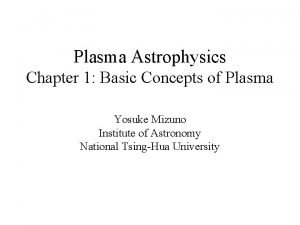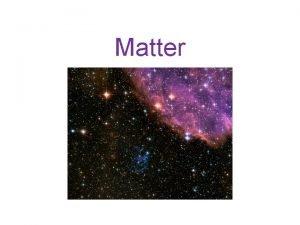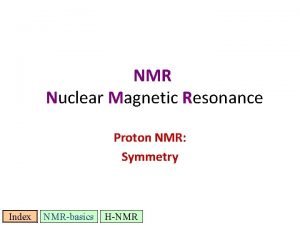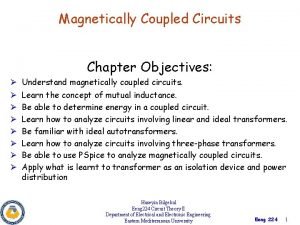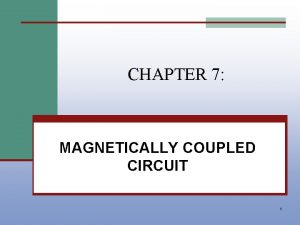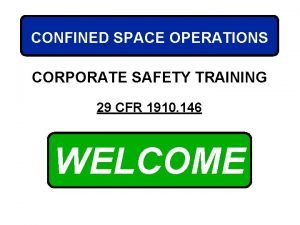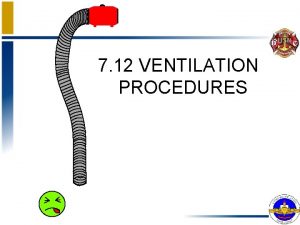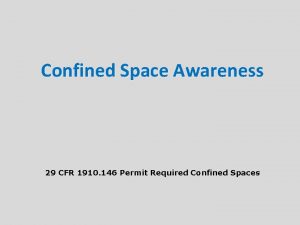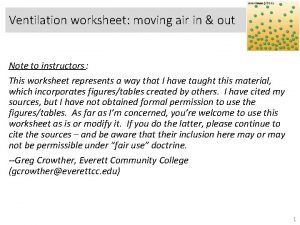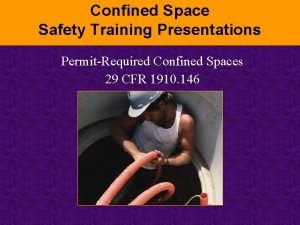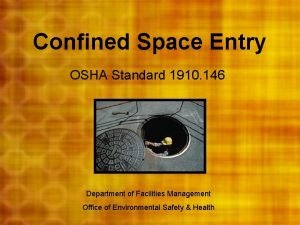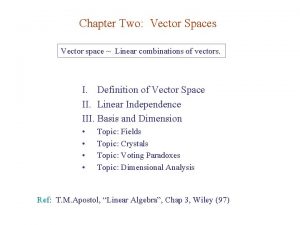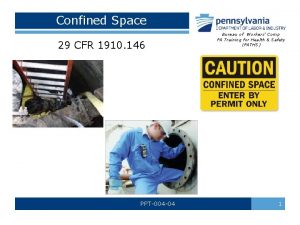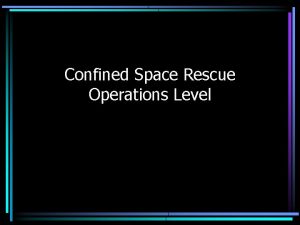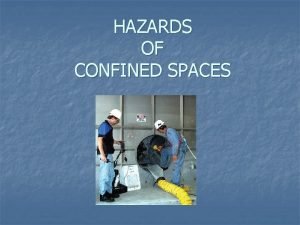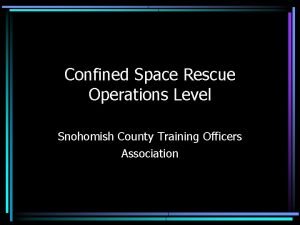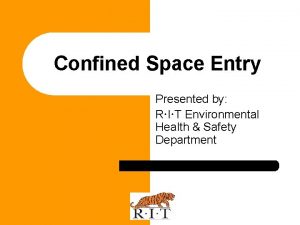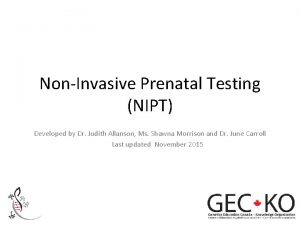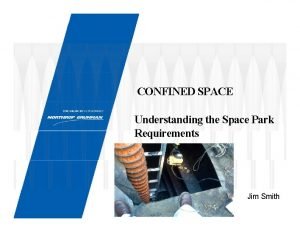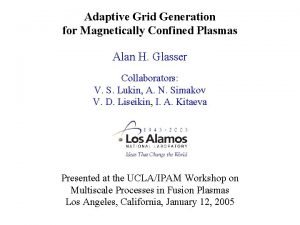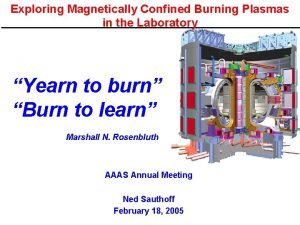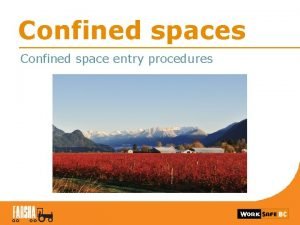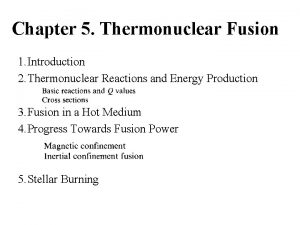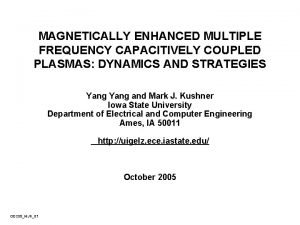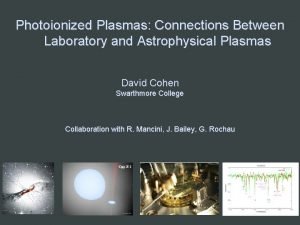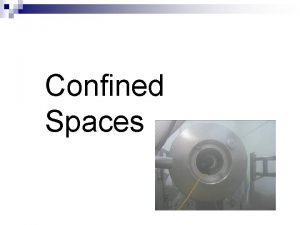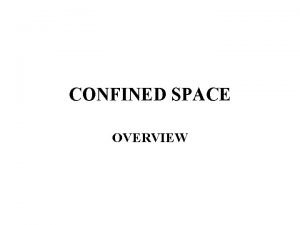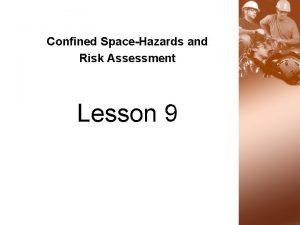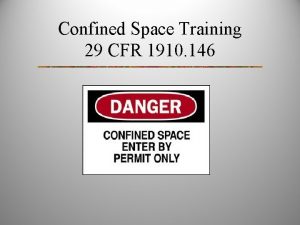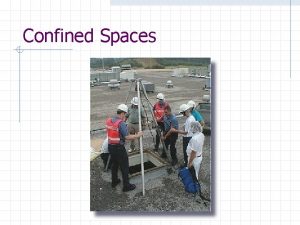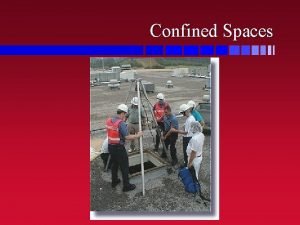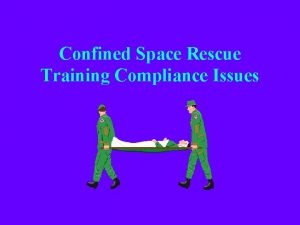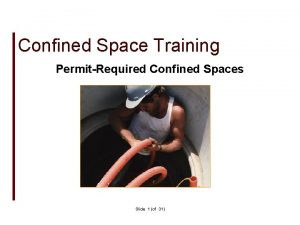Magnetically Confined Thermonuclear Grade Plasmas K Lackner MaxPlanck



























- Slides: 27

Magnetically Confined Thermonuclear Grade Plasmas K. Lackner Max-Planck Institut für Plasmaphysik, D-85748 Garching • introduction: toroidal magnetic confinement • parameter regime of magnetic fusion • temperatures, pressures, n. Tt • the dimensionless parameters of magnetic fusion • the non-local nature of thermodynamic equilibria • axisymmetric (tokamaks) • general toroidal (stellarators) • frontier physics issues of magnetic confinement • turbulent transport - transport barriers • fast particle driven global instabilities • conclusions: Matter under Extreme Conditions Brijuni, Sept. 1, 2004 1

principle of toroidal magnetic confinement end losses avoided by nested, closed toroidal flux surfaces magnetic field reduces drastically perpenticular mobility of particles balances the plasma pressure (O(10 atm)) produces thermal insulation ( 200 Million K) Matter under Extreme Conditions Brijuni, Sept. 1, 2004 2

the need for a „rotational transform“ : iota build-up of charge separation field leading to radial drift superposition of poloidal field component allows particle motion along field lines to cancel out charges „Rotationstransformation“: iota= 1/q can be produced either by a toroidal net current, or by giving up axi-symmetry Matter under Extreme Conditions Brijuni, Sept. 1, 2004 3

parameter regime of magnetic fusion DT fusion requires T in 10 ke. V-range to balance conductive heat losses (~ n. TV/t. E) to maximize fusion power density (~ p 2(<sv>/T 2) Matter under Extreme Conditions Brijuni, Sept. 1, 2004 4

the push to ignition (high Q ~n. Tt) progress only size and time, but also parameter regime of not magnetic „new regimes“ fusion n. . . plasma density T. . . plasma temperature learning t. . . energy confinement time (a measure of the quality of thermal insulation) money Matter under Extreme Conditions Brijuni, Sept. 1, 2004 5

time scales of a of fusion plasma physics both particle species are well thermalized - although not necessarily at Te = Ti Particles complete many orbits between 90 o deflections Fusion plasmas can be generally considered quasineutral Matter under Extreme Conditions Brijuni, Sept. 1, 2004 6

basic science aspect of magnetic fusion plasmas A quasi-neutral plasma (for given geometrical configuration) characterized by 3 dimensionless parameters - 4 dimensional ones: n, B, T, R -> allows for „dimensionless identity experiments“ finite orbit effects collisionality Plasma pressure modification of magnetic field Basic science - plasma physics interest: Applied (energy science) interest: • nearly collisionfree • fusion temperatures • orbits small compared to dimensions • confinement • effective use of magnetic pressure • plasma pressure significant Matter under Extreme Conditions Brijuni, Sept. 1, 2004 7

novelty of plasma physics regime of a reactor (ITER) (ASDEX-Upgrade/DIII-D; JET/JT 60 -U are geometrically similar, scaled versions of ITER) (examples EU) ASDEX-Upgrade R = 1. 6 m JET R = 3 m Matter under Extreme Conditions Brijuni, Sept. 1, 2004 ITER R=6 m 8

novelty of plasma physics regime of a reactor (ITER) We can define also dimensionless „machine properties“ (known a priori) ITER JET ITER (and a reactor): AUG • will have similar b, n* • r*, n* significantly smaller at constant n*, for ITER 98(y, 2) Matter under Extreme Conditions Brijuni, Sept. 1, 2004 9

consequences of the nonlocal equilibrium distribution finite orbit size, different orbit classes + steep gradients in rigorous axisymmetry (ideal tokamak): conservation of generalized toroidal momentum (in addition to magnetic moment and energy) RAf = Y. . . poloidal flux function equilibrium distribution: collisions tend to reconcile conflict between g(P) and g(Y). . -> „neoclassical“ transport For tokamak: • neoclassical transport resolved in 60 ies • broad range of implications: - off-diagonal terms • bootstrap-current (a pressure driven current) • Ware-Pinch (an E-field driven inward drift) Matter under Extreme Conditions Brijuni, Sept. 1, 2004 10

classical transport in a stellarator absence of „ignorable coordinate“ <-> no momentum-like constant of motion collisional tansport in „nonoptimized“ stellarator collisional tansport in tokamak gyration-averaged motion of particle on „loss-orbit“ (typical level of) turbulent tansport in tokamaks Matter under Extreme Conditions Brijuni, Sept. 1, 2004 11

Boozer/Nührenberg: otimized stellarator In „drift-approximation“ (gyro-averaged motion): particle motion dependent only on variation of /B/ on flux-surface. . . “quasi-symmetry“ In quasi-symmetry: gyro-centers remain on closed surfaces -> “tokamak-like” neoclassical transport e. g. : quasihelikale Symmetrie B = B(s, ) Matter under Extreme Conditions Brijuni, Sept. 1, 2004 12

optimised stellarators: a field of vivid research on configurations strict quasi-symmetry“ not needed for sufficient collisional confinement W 7 X freedome can be used to satisfy additional requirements Matter under Extreme Conditions Brijuni, Sept. 1, 2004 13

optimised stellarators: a field of vivid research on configurations strict quasi-symmetry“ not needed for sufficient collisional confinement • adequate collisional confinement • high stable b • suppression or utilisation of bootstrap-current • characteristics of turbulent transport • divertor compatibility • reactor compatible coil configurations Matter under Extreme Conditions Brijuni, Sept. 1, 2004 14

most active magnetic confinement physics areas: (1) turbulence and turbulent transport Turbulence (and nonlinear MHD) imply 3 -d structures: differences stellarator - tokamak diminish 1/t frequency unit: sound wave transit L mode scale unit: ion gyroradius ETG-modes unstable driving modes span broad range of space and time scales: orbit effects and orbit classes of particles important (generally) kinetic description needed (only gyromotion can be treated by averages) ITG modes MHD modes TE modes confinement time size finite Lamor radius effects! Finite drift orbit effects! r. L, i Matter under Extreme Conditions Brijuni, Sept. 1, 2004 15

turbulence and turbulent transport: (important) example: drive by ion-temperature gradient instability compression produces an E-field gives rise to a drift which on the “outer” side of the torus brings hot plasma from the core - in phase with original perturbation Matter under Extreme Conditions Brijuni, Sept. 1, 2004 16

ITG turbulence predictions: kinetic vs. fluid modelling: cyclone benchmark case R/LTi, linear “critical gradient” R/LTi and steep rise of c(R/LTi ) produce stiff logarithmic T-profiles -> strong effect of edge T GK: R/LTi, non-linear Matter under Extreme Conditions Brijuni, Sept. 1, 2004 17

the effect of sheared rotation: macroscopic sheared rotation squeezes /breaks radially extended eddies turbulent Reynold stresses can self-generate macroscopic rotation*) radial transport proportional to radial eddy-size (~ correlation length) Matter under Extreme Conditions Brijuni, Sept. 1, 2004 *) also fast-particle losses & neoclass. 18 effects

edge transport barriers spontaneous formation of (narrow) zones of sheared rotation -> localized transport barrier profile stiffness • amplifies edge pedestal • bifurcation in confinement H-mode discovery on ASDEX (82) Matter under Extreme Conditions Brijuni, Sept. 1, 2004 19

internal transport barriers variety of transport barriers also in plasma interior (also in combination with H-mode edge) Importance: large bootstrap current • possibility of stationary operation Matter under Extreme Conditions Brijuni, Sept. 1, 2004 issue: stationary control 20

most active magnetic confinement physics areas: (2) fast particle interaction with global MHD modes • fusion a-heating unique; isotropic, va > v. Alfven • loss would imply loss of heating Detailled particle kinetics important for global mode interaction: • mode amplitude radial gradients over size of particles orbit • resonance with particle motion displacement vector for m=1/n=1 mode Large gradients in field perturbation r Matter under Extreme Conditions Brijuni, Sept. 1, 2004 21

modes driven by resonance with particle motion: Alfvén-type modes • resonance with existing, marginally stable mode • energy for mode growth from expansion energy realistic situation • not accelerated slowing down but confinement loss cylinder: • continuum of localized modes • phase mixing -> continuum damping TAE. . toroidicity EAE. . . ellipticiy NAE. . . triangularity induced Alfven eigenmodes e = 0. 3 KTAE kinetic toroidicity. . . e=0 CLM core localized TAEs e = 0. 3 toroidal (or other) coupling: • gaps • global modes - excitable Matter under Extreme Conditions Brijuni, Sept. 1, 2004 22

theoretical understanding & experimental verification • frequencies very precise (diagnostic tool) • competition between stabilizing (other fast particles) destabilizing terms good: dependence on detailed particle distribution Manipulation of distribution function by heating method explanation and modelling of nonlinear splitting as function of instability drive by trapping of particles in wave Matter under Extreme Conditions Brijuni, Sept. 1, 2004 JET 23

theoretical understanding & experimental verification observation of a-particle produced TAEs in deuterium-tritium experiments on TFTR Damping by NBI supresses TAE a-particle slowing - down slower TAEs appear in phase with still a, but no NBI Measured structure correspond well to simulation Matter under Extreme Conditions Brijuni, Sept. 1, 2004 24

Summary & Conclusions in physics: basic science interest the laboratory realization of plasmas, which are/have nearly collision-free, strongly magnetized, high kinetic/magnetic pressure ratio and requirements for realization of a burning plasma are practically collinear we are currently preparing construction/building two exciting, very different experiments: ITER & W 7 -X Matter under Extreme Conditions Brijuni, Sept. 1, 2004 25

fusion: a vision from 50 years ago Matter under Extreme Conditions Brijuni, Sept. 1, 2004 26

from science fiction to the blueprints of a test reactor ITER (scaled) Matter under Extreme Conditions Brijuni, Sept. 1, 2004 27
 What are plasmas
What are plasmas What are plasmas
What are plasmas Homotopic protons
Homotopic protons Magnetic coupling in transformer
Magnetic coupling in transformer Gullivers travel agency
Gullivers travel agency Magnetically coupled circuits lecture notes
Magnetically coupled circuits lecture notes Confined space quiz
Confined space quiz Confined space rescue equipment
Confined space rescue equipment Confined space gas limits
Confined space gas limits Ventilation calculation formula for confined space
Ventilation calculation formula for confined space 1910 confined space
1910 confined space Confined space rescue equipment
Confined space rescue equipment Ventilation worksheet
Ventilation worksheet Confined space presentation
Confined space presentation Cabined cribbed confined
Cabined cribbed confined Characteristics of confined space
Characteristics of confined space 1910-146
1910-146 Confined space refresher training
Confined space refresher training How to determine subspace of vector space
How to determine subspace of vector space 1926 subpart aa
1926 subpart aa Obtain authorization before entering a confined space
Obtain authorization before entering a confined space Confined space training ppt
Confined space training ppt Saba confined space
Saba confined space Confined space definition bc
Confined space definition bc Saba confined space
Saba confined space Confined spaces
Confined spaces Sips vs nipt
Sips vs nipt Confined space rescue equipment
Confined space rescue equipment
